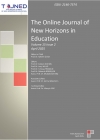TOJNED - Volume 10 - Issue 1 - January 2020
 A MOBILE LEARNING COMMUNITY IN A LIVING LEARNING COMMUNITY: PERCEIVED IMPACT ON DIGITAL FLUENCY AND COMMUNICATION
A MOBILE LEARNING COMMUNITY IN A LIVING LEARNING COMMUNITY: PERCEIVED IMPACT ON DIGITAL FLUENCY AND COMMUNICATION Devshikha Bose, Krishna Pakala, Lana Grover
Abstract:
Though mobile devices like smartphones, tablets, and tablet computers have an immense potential for improving student learning, there is little empirical research which reports ways in which students actually use these technologies for learning, especially in fields like Engineering. Based on a social-constructivist approach to learning, the purpose of this mixed methods study was to investigate student perceptions regarding changes in mobile device based digital fluency and communication, after participation in a Living Learning Community (LLC) based Mobile Learning Community. This study contributes to existing literature in the field in that it reports student perceptions of how mobile devices can support learning, impact soft skill practice through peer communication, and enhance basic digital fluency among students living in an Engineering LLC. Based on the findings of this study, recommendations are made which might be useful for LLC Faculty in Residence (FIRs), housing staff, and those working with LLCs.
 BOOSTING LISTENING COMPETENCE OF L2 LEARNERS THROUGH READING SCRIPTS
BOOSTING LISTENING COMPETENCE OF L2 LEARNERS THROUGH READING SCRIPTS Reima Abobaker, Ibtesam Hussein
Abstract:
This pilot study investigated the impact of reading a written script on the second language listening achievement of high intermediate English as second language (L2) students. Thirty-five high-intermediate ESL students participated in this study. The participants took part in both the bassline conditions (listening without the script intervention) and the reading intervention condition (listening along with a script). The scores of the tests were analyzed using paired sample t-test. The findings revealed that there was a significant difference between the two conditions. The reading intervention has
a major effect on second language listening comprehension performance of L2 learners.
 CORRELATION BETWEEN ENVIRONMENTAL LITERACY COMPONENTS (KNOWLEDGE, ATTITUDE AND BEHAVIOR) IN MADEIRA ISLAND (PORTUGAL) 9TH GRADE STUDENTS
CORRELATION BETWEEN ENVIRONMENTAL LITERACY COMPONENTS (KNOWLEDGE, ATTITUDE AND BEHAVIOR) IN MADEIRA ISLAND (PORTUGAL) 9TH GRADE STUDENTS HĂ©lder SpĂnola
Abstract:
Pearson’s correlations among environmental literacy main components for 9th grade students from Madeira Island (Portugal) reveal the known intricacy of the framework for environmentally responsible behaviors. Findings show that knowledge, attitude and behavior correlate each other positively and significantly in a small level, and that demographic variables strongly influence these relationships. The established relationship among the environmental literacy main components shows a pathway where knowledge has greater ease on changing attitudes (r=0.276, p=0.000) than behaviors (r=0.198, p=0.000), being behaviors more related to attitudes (p=0.224, p=0.000). Also, since the shared variance between components was very small, other factors not evaluated on present study should play a major role among 9th grade students from Madeira Island.
 EXAMINING THE LINK BETWEEN MULTICULTURAL EDUCATION AND EQUITY SCHOOLING IN CHANGING MALTA
EXAMINING THE LINK BETWEEN MULTICULTURAL EDUCATION AND EQUITY SCHOOLING IN CHANGING MALTA Brian Vassallo
Abstract:
The study examines how Maltese school leaders who have completed an educational leadership program in the past six years understand the concept of equity schooling and the role that multicultural education plays in the formation of polices which aid this important quest. The qualitative method of investigation was used throughout the study. The semi-structured interview method was thought to be ideal since it allowed the researcher to probe (McLeod, 2014) into the interwoven links between Multicultural education and equity schooling. It also allowed participants to feel at ease with the researcher thus increasing the validity of the study. 55% of the school leaders interviewed were familiar with the concept of equity schooling. Ten percent of those interviewed equated multicultural education with social justice whilst stressing on equal participation of all children irrespective of children’s cultural or linguistic background while 20% perceived multicultural education as an essential prerequisite towards fair and equal distribution of resources. Only 35% of respondents spoke about equity schooling in terms of ‘cultural proficiency’, ‘cultural competence’, ‘responding to cultural backgrounds’, or similar notions. This indicated a dire need for more emphasis on school equity issues in schools together with an infusion of culturally responsive education courses within Educational Leadership programs.
 LEARNING STYLES AND PERSONALITY TRAITS OF COMPUTER SCIENCE UNDERGRADUATES IN MALAYSIA 49
LEARNING STYLES AND PERSONALITY TRAITS OF COMPUTER SCIENCE UNDERGRADUATES IN MALAYSIA 49 Nor Rahayu Ngatirin, Zurinahni Zainol
Abstract:
Learners come with diversity in their individual needs and characteristics such as different learning styles and preferences, personality traits and cognitive abilities. The aim of this study is to investigate the relation between the Felder-Silverman learning styles, the Big Five personality traits, and gender among Computer Science undergraduates. 90 students completed a demographic data form, the Index of Learning Styles (ILS), and the Big Five Inventory (BFI). A quantitative research methodology was used to conduct the study. Statistical Package for the Social Sciences (SPSS, version 24.0) was used for statistical analysis. Results have shown that the most common learning style was visual and the majority of students had neuroticism personality trait. There was no significant relationship between gender and learning styles or personality traits. Further finding indicated that there was no significant relationship between the students’ learning styles and their personality traits.
 SOCIAL PRESENCE IN AN ONLINE TEACHER EDUCATION PROGRAM: PRE-SERVICE TEACHER PERCEPTIONS 60
SOCIAL PRESENCE IN AN ONLINE TEACHER EDUCATION PROGRAM: PRE-SERVICE TEACHER PERCEPTIONS 60 Tracey K. Hoffman, Thomas Mays
Abstract:
The Prekindergarten Associate degree program, offered on the regional campuses at a public Midwestern university, is a teacher preparation program designed for students planning to teach children birth through age five in a childcare or preschool setting. Many students in the program are nontraditional, often working full time and caring for family members. The program was changed from face-to-face to a fully online format to improve access for these nontraditional students. As the program launched, the researchers were concerned about the impact of moving to a fully online format on the online social learning environment. Students from two online Prekindergarten courses were invited to complete a survey to learn more about their perceptions of social presence in the online courses. Additionally, a small group of randomly selected students was invited to participate in an interview. Study participants reported that the new online format created an accessible way to earn their associate degree that they would not have been able to do if the program was in a face-to-face format. However, some students also stated that social presence was not a high priority since their primary goal was to earn a degree.
 STUDENT WORKSHEETS BASED ON DISCOVERY LEARNING COMBINED WITH ASSESSMENT FOR LEARNING HIGHER ORDER THINKING SKILLS (AfL HOTS) TO FOSTERING HIGH LEVEL THINKING SKILLS OF STUDENTS 69
STUDENT WORKSHEETS BASED ON DISCOVERY LEARNING COMBINED WITH ASSESSMENT FOR LEARNING HIGHER ORDER THINKING SKILLS (AfL HOTS) TO FOSTERING HIGH LEVEL THINKING SKILLS OF STUDENTS 69 Khoiriah, Tri Jalmo
Abstract:
This study aims to describe the effectiveness of student worksheets based on discovery learning combined with assessment for learning higher order thinking skills in fostering high-level thinking skills of students especially in human circulatory system material. True experimental research design is a type of pretest-posttest control group with subjects consisting of two groups of eighth grade students of junior high school taken by random sampling. The research instrument in the form of student worksheets based on discovery learning combined with assessment for learning higher order thinking skills results of development with the feasibility of having guaranteed expert team validation and limited trials. Data collection research was conducted using observation sheets of high-level thinking skills and higher order thinking skills oriented cognitive test questions. The research data were analyzed descriptively qualitatively and quantitatively using t test. The results of data analysis showed the results of observations student behavior in the experimental class 1 and experimental class 2 which corresponded to the indicators of high-level thinking skills categorized as "very high" that is 80,83% analyzing, evaluating 81,90% and creating 82,33% while the results of the analysis response data of students' answers to higher order thinking skills cognitive test questions using the t test obtained sig (2-tailed < 0,05), namely sig (2-tailed) = 0,000. Thus the student worksheets based on discovery learning combined with assessment for learning higher order thinking skills in learning specifically on human circulatory system material is declared to be effective in fostering students' high-level thinking skills.


